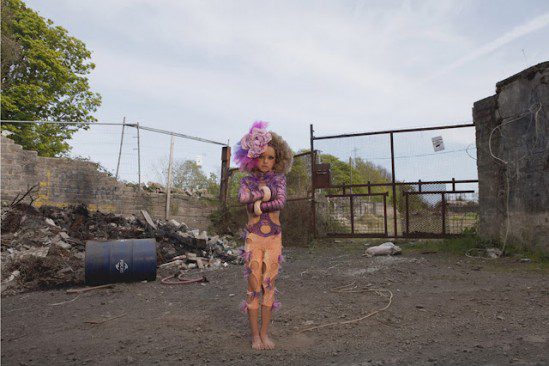Text by Angela Darby
Below the gilded King Edward VII chandeliers and between the Italian travertine engraved marble walkway the exhibition Contemporary Art in Northern Ireland is situated in The Great Hall of Parliament Buildings at Stormont. The exhibition’s curator Dr Suzanne Lyle, Head of Arts and Acquisitions at the Arts Council of Northern Ireland, states: “The invitation from the Speaker to bring this exhibition to Parliament Buildings is an important opportunity to champion our artists… business leaders will cite the strength of a society’s arts and culture as a key factor influencing any decision to invest…” Staging the exhibition in Stormont is a positive step to improving public access and additionally the political decision makers who allocate cultural funds can view firsthand the quality of the works on display. The 24 selected artists are drawn from emerging and established artists. Miguel Martin (b.1985), a talented young artist pays homage to an established artist with an intricate, detailed line drawing entitled Neil Shawcross’s Studio Space whilst internationally recognised artist Colin Darke (b.1957) raises questions concerning intellectual copyright and appropriation in his painting Mannish Boy V – Policeman. This breadth of practice is well represented throughout the exhibition.
Brendan Jamison’s (b.1979) large impressive sculpture Yellow Helicopter shares an eyeline with the bronze statue of Sir James Craig, the first Prime Minister of Northern Ireland. The striking work grabs the viewers’ attention with its skeletal composition and bright woolly draped flesh. The piece sits in The Hall as an ironic testament to the military occupation of Northern Ireland’s past. Artists such as Christopher McCambridge and Jennifer Trouton seem to relate metaphorically to the environment. In Re-interpretation: Falling for Grandeur, McCambridge meticulously stitches his canvas with royal blue, blossom pink and turquoise threads. The chinoiserie wallpaper referenced is rendered by the artist’s physical action into a luxurious tapestry, an historical artefact echoing the affluence of the architectural environment within which it hangs. Trouton’s oil on linen painting Harrow captures a similar sensibility. An intricate photo-realist painting of a textured blanket draped over a chair suggests a story of comfort and tranquillity. But the fragments of broken crockery strewn and discarded beside the chair disturb the picture’s equilibrium. As the painting’s title suggests there is no room for harmony.
Simon McWilliams’ oil on canvas, Stairwell captures a fragment of Belfast’s prolific re-development that spread throughout the city like a raging virus. Resembling invasive weeds on a riverbank, green fluorescent netting and scaffolding provide a stagnant ‘still’ from an emergent tower block’s metamorphic growth. Caught in a frozen moment the image reveals the city’s faltering regeneration. The artists Terry McAllister, Gareth Reid, Gail Ritchie and Robert Peters poignantly capture aspects of rural landscapes and woodlands. Ritchie’s Dead Tree, a fine graphite pencil drawing on paper, hauntingly commemorates the traditional 12th of July Orange March to the field in Edenderry Village, Belfast. The faces of menacing sprites and gargoyles emerge from the gnarled bark and twisted knots on the tree’s decaying surface. The tree’s totemic symbolism seems to point to a time before the transformation of the province’s political situation and a time when one community had a monopoly over the other. Robert Peters’ digital print, entitled Uccello of the Potato Field I and II, portrays a traditional children’s game played in the potato fields on his family farm during the 1970s. This is not a game of childish innocence however but one of brutal combat as the sport’s object is to target and hurt one’s opponent by hurling potatoes propelled from the sticks. Peters has arranged the composition of his improvised weaponry to correspond with the upright lances in The Battle of San Romano (1438-1440) by the Florentine painter Paolo Uccello.
In the works by Zoe Murdoch, Maria McKinney, Shaleen Temple and Carrie McKee there is a polar presence of escapism and capture. Murdoch’s sensitive and melancholic sculpture Oh Muse Be Near Me Now and Make a Strange Song is dedicated to a long distanced correspondence. The anatomical objects and printed text contained within the small wooden box form clues to the artists’ reflection on the frustrations of a relationship spent apart. Maria McKinney examines the pursuit of leisure time and the activities devised to combat monotony in an appropriated jigsaw composition The Earl of Leicester. The photographic portraits by Temple and McKee poignantly narrate the condition of each of their subject’s entrapment. From the series entitled Boys and Girls, Temple’s documentation of South African servants exposes a world of subordination and subservience. The artist’s subject, Jerita stands tentatively in the interior of her employer’s home in Johannesburg. The red wall’s arch and dark wooden furniture frames and engulfs Jerita, the very objects that define her occupation seem to imprison her. Temple draws attention to these domestic servants who would otherwise be overlooked and in so doing she credits them with the recognition that they deserve. McKee chooses the backdrop of derelict Belfast cityscapes for her stunning depictions of young dancers. In Orlaigh (2011), a girl poses defensively with her arms folded; she is dressed in a bright orange and fuchsia coloured costume, a large pink blossom frames her face. This beautiful, ‘tiger lily’ sprouts with strength and determination from the desolate wasteland, waiting for her hopes and aspirations to be fulfilled.
One can easily imagine how Stormont’s opulent surroundings and ornate architectural features might overshadow the exhibiting works, rendering them undistinguished and lacking in impact. Surprisingly this is not the case; Dr Lyle’s strong curatorial vision corresponds with the context of this stately environment.
Contemporary Art in Northern Ireland, 21/11/2011 – 04/01/2012, Parliament Buildings, Stormont. www.artscouncil-ni.org
Aesthetica Magazine
We hope you enjoy reading the Aesthetica Blog, if you want to explore more of the best in contemporary art and culture you should read us in print too. You can buy it today by calling +44(0)1904 479 168. Even better, subscribe to Aesthetica and save 20%. Go on, join us!
Caption:
Carrie Mckee Gilded Youth – Orlaigh Burns 2011
Courtesy the artist





